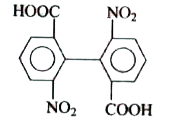Which of the following complex exhibit facial meridional geometrical isomerism.
[Pt(NH3)Cl3]−
[PtCl2(NH3)2]
[Ni(CO)4]
[Co(NO2)3(NH3)3]
The correct Answer is:D
To determine which of the following complexes exhibit facial and meridional geometrical isomerism, we need to analyze the coordination number and the arrangement of ligands in the complexes provided.
1. Understanding Geometrical Isomerism:
- Geometrical isomerism in coordination compounds can occur in octahedral complexes (coordination number 6) with the general formula MA3B3, where A and B are different ligands.
- In these complexes, we can have two types of isomers:
- Facial (FAC): where the same type of ligands occupy adjacent positions.
- Meridional (MER): where the same type of ligands occupy positions that form a plane through the metal center.
2. Identifying the Coordination Number:
- We need to check the coordination number of each complex given in the options. Only complexes with a coordination number of 6 can exhibit facial and meridional isomerism.
3. Analyzing Each Option:
- Option A: Platinum complex with 4 ligands (3 Cl and 1 NH3).
- Coordination number = 4.
- Conclusion: Does not exhibit facial/meridional isomerism.
- Option B: Another platinum complex with 4 ligands (2 Cl and 2 NH3).
- Coordination number = 4.
- Conclusion: Does not exhibit facial/meridional isomerism.
- Option C: Nickel complex Ni(CO)4.
- Coordination number = 4.
- Conclusion: Does not exhibit facial/meridional isomerism.
- Option D: Cobalt complex with 6 ligands (3 NH3 and 3 NO2).
- Coordination number = 6 (A3B3 type).
- Conclusion: Exhibits both facial and meridional isomerism.
4. Final Answer:
- The only complex that exhibits facial and meridional geometrical isomerism is Option D.
Summary:
- Correct Option: D (Cobalt complex with 3 NH3 and 3 NO2 ligands).
- Geometrical isomerism in coordination compounds can occur in octahedral complexes (coordination number 6) with the general formula MA3B3, where A and B are different ligands.
- In these complexes, we can have two types of isomers:
- Facial (FAC): where the same type of ligands occupy adjacent positions.
- Meridional (MER): where the same type of ligands occupy positions that form a plane through the metal center.
- We need to check the coordination number of each complex given in the options. Only complexes with a coordination number of 6 can exhibit facial and meridional isomerism.
- Option A: Platinum complex with 4 ligands (3 Cl and 1 NH3).
- Coordination number = 4.
- Conclusion: Does not exhibit facial/meridional isomerism.
- Option B: Another platinum complex with 4 ligands (2 Cl and 2 NH3).
- Coordination number = 4.
- Conclusion: Does not exhibit facial/meridional isomerism.
- Option C: Nickel complex Ni(CO)4.
- Coordination number = 4.
- Conclusion: Does not exhibit facial/meridional isomerism.
- Option D: Cobalt complex with 6 ligands (3 NH3 and 3 NO2).
- Coordination number = 6 (A3B3 type).
- Conclusion: Exhibits both facial and meridional isomerism.
- The only complex that exhibits facial and meridional geometrical isomerism is Option D.
- Correct Option: D (Cobalt complex with 3 NH3 and 3 NO2 ligands).
Similar Questions
Knowledge Check
Which of the following compounds will exhibit cis-trans (geometrical) isomerism?
ABut-2-eneBBut-2-yneCButan-2-olDBut-1-eneWhich of the following compounds exhibit optical isomerism?
A BH2C=C=CH2C
BH2C=C=CH2C D
D
Which of the following would exhibit cis-trans isomerism?
ACH3CH2CH=CH2BClCH=CHClCClCH=CCl2DCH2=CH−COOH
Which of the following compounds will exhibit cis-trans (geometrical ) isomerism ?
View SolutionWhich of the following compounds will exhibit cis-trans (geometrical ) isomerism ?
View SolutionWhich of the following complex compound exhibits geometrical isomerism?
View SolutionWhich of the following compounds exhibit geometrical isomer ?
View SolutionWhich of the following complexes ionization isomerism ?
View Solution
